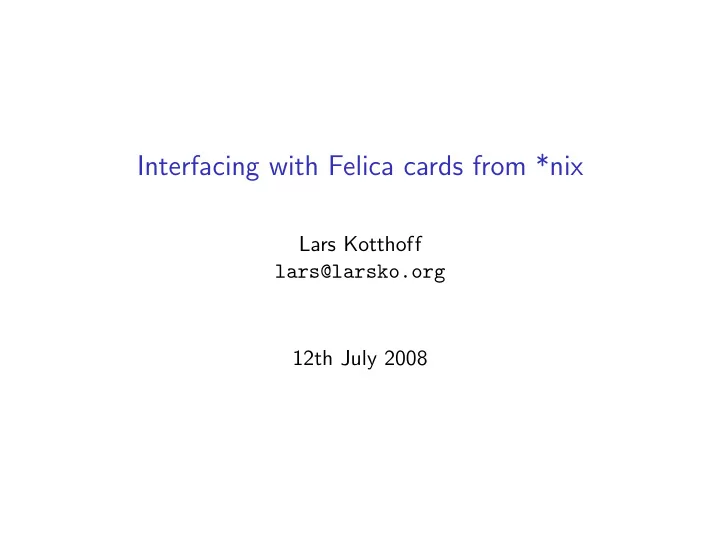

Interfacing with Felica cards from *nix Lars Kotthoff lars@larsko.org 12th July 2008
Outline 1 Introduction Felica PC Interface 2 libpasori Introduction Interface 3 ViewSuica Requirements Architecture Implementation 4 Demonstration 5 Conclusion Problems
Felica • RFID IC card developed by Sony • cards are completely passive, activated and powered by external reader • can store encrypted data which requires authentication to access • used mostly for electronic money, e.g. Suica/Pasmo • used in Hong Kong, China, Japan. . .
Hardware • built-in reader/writer in Sony VAIO laptops • external USB reader/writer available from Sony and third-party vendors Pasori RC-S320
Software • Windows software to read the (unencrypted) data stored on the card and make internet purchases provided by Sony SFCard Viewer
3rd-party software • IC SFCard Fan project • documentation • various tools to access various Felica cards • webservice to resolve the station/line codes stored on Suica/Pasmo • it’s all in Japanese • all the software is for Windows
Enter libpasori
libpasori to the rescue • library to interface with the Pasori USB reader • works with Linux, BSD, Solaris, Windows • sample applications • links to other projects • card viewer for MAC OS X • video of somebody using a Felica card as a key
Interface • libpasori provides basic functions to interface with the reader and card • poll the reader for a card • read/write • send/receive raw commands • very little documentation • lots of magic bits and bytes to set to make the functions do what you want
ViewSuica
Requirements • provide the same functionality as the reader application provided by Sony • work on as many platforms as possible. . . • . . . with special focus on Linux
Architecture • application needs to interface with • libpasori to access the card • IC SFCard fan webservice to resolve the codes stored on the card to names • abstraction from the low-level details • graphical user interface
Implementation language: Ruby • easy to write a module to talk to libpasori • easy to call webservices • easy to write GUIs • available for many platforms
pasori-ruby • Ruby module to access the libpasori functions • encapsulation of the gory details and conversion of the integer array returned by the read function into a map • provides methods to connect/disconnect a reader and read the current value and the history (the last 20 transactions)
GUI • written in QT4 • GUI designed with Trolltechs QtDesigner • Ruby code for the GUI is generated from the XML description generated by QtDesigner • the actual application subclasses the generated class and implements the actual methods • display the information stored on the card and provide a button to update it
Webservice • IC SFCard Fan database provides WSDL • simply tell the Ruby SOAP implementation to process the WSDL and off you go • resolves the codes in a background thread
Demonstration
Problems • only little (Japanese) documentation • IC SFCard Fan DB WSDL fails validation because of the declared namespace • Qt and Ruby threads don’t play nicely together • all Qt stuff happens in C – other Ruby threads don’t get a chance to run • attach a timer which fires periodically to give Ruby a chance to schedule other threads
Conclusion • finally an application to read Suica/Pasmo in Linux • not perfect, but you get the basic functionality • nice start to Felica hacking
Resources IC SFCard Fan http://www014.upp.so-net.ne.jp/ SFCardFan/index.html libpasori http://libpasori.sourceforge.jp/ Felica/Suica/Pasmo http://ja.wikipedia.org/
Questions, anyone?
Recommend
More recommend